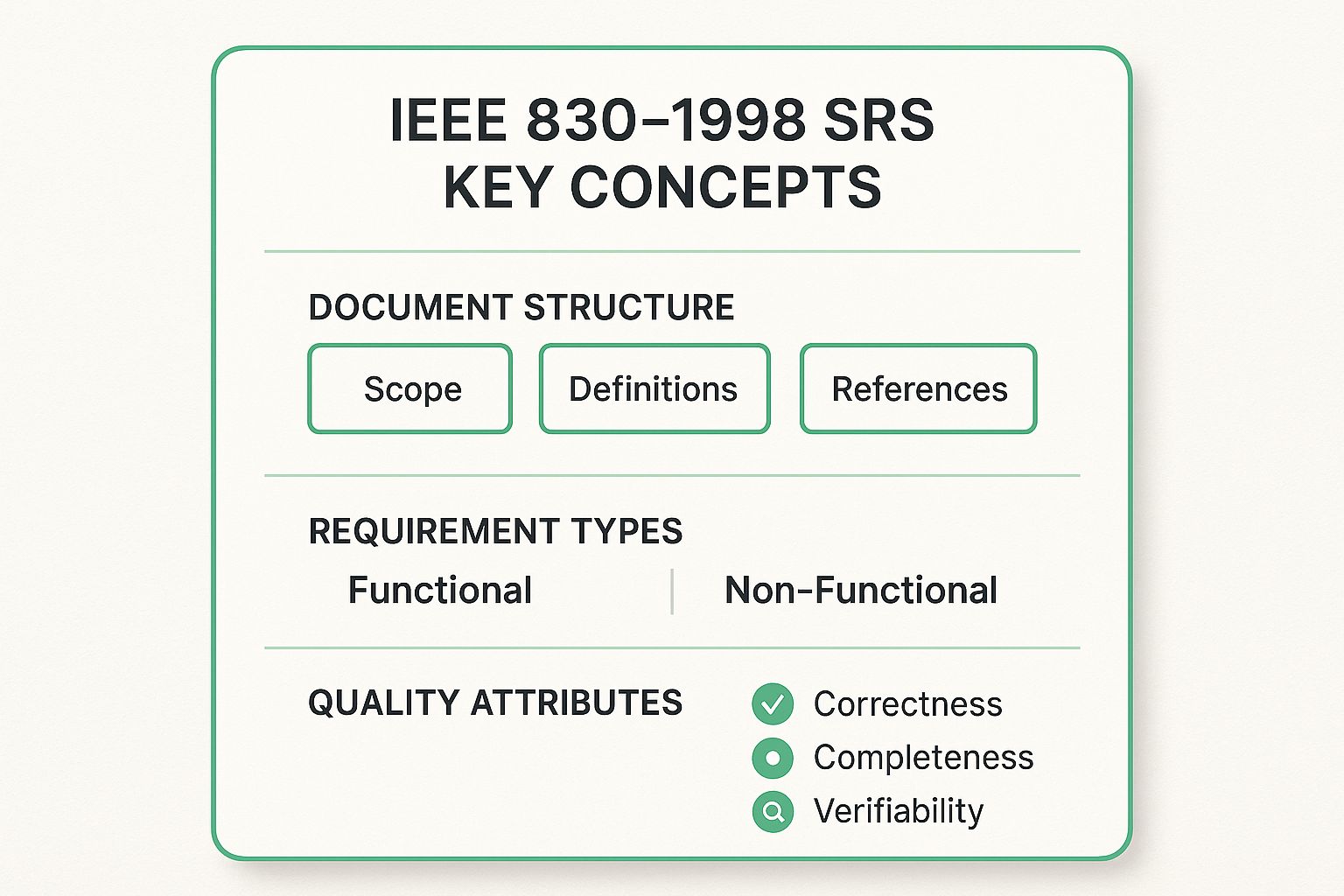Explore 6 detailed technical requirements document sample templates. Learn how to write effective TRDs for any project, from APIs to mobile apps.
In software development, a well-crafted Technical Requirements Document (TRD) is the architectural blueprint separating successful projects from costly failures. It translates abstract business needs into a precise, actionable language for engineering teams, ensuring everyone builds the same product with the same understanding. But creating an effective TRD from scratch can be a daunting and error-prone process.
To demystify this critical step, we have curated six distinct and powerful technical requirements document sample templates. This listicle goes beyond simple outlines. We will dissect each sample, revealing the strategic thinking behind its structure, providing tactical insights you can apply immediately, and offering actionable takeaways to elevate your own documentation process. From classic IEEE standards to modern microservices and API specifications, these examples provide a replicable framework for clarity and execution.
This structured approach ensures that what is designed is precisely what gets built, which is a crucial foundation for later project phases. For robust validation of your technical requirements once development is complete, consider utilizing a comprehensive User Acceptance Testing (UAT) template to confirm the system meets user needs effectively.
Need to generate complex technical documents with speed and precision? Discover how DocuWriter.ai can automate and streamline your documentation workflow.
The IEEE 830-1998 standard, while officially superseded, remains a foundational framework for creating a comprehensive Software Requirements Specification (SRS). It provides a structured, rigorous methodology for documenting functional and non-functional requirements, making it an enduring gold standard, particularly for complex, high-stakes projects. This approach ensures that every aspect of the software, from user interactions to underlying performance metrics, is defined, verifiable, and agreed upon before development begins.
The core strength of the IEEE 830 standard lies in its emphasis on creating a document that is correct, unambiguous, complete, consistent, verifiable, and traceable. It forces teams to think through every requirement with a level of detail that minimizes assumptions and reduces the risk of costly rework later in the development lifecycle.
This template is far more than a simple checklist; it’s a strategic tool for risk management. By enforcing a standardized structure, it creates a single source of truth that aligns diverse stakeholders, including developers, QA testers, project managers, and clients.
The following infographic highlights the foundational concepts of the IEEE 830-1998 framework, breaking down its structure, requirement types, and key quality attributes.

This visual summary underscores the template’s methodical approach, which forces teams to categorize requirements logically and evaluate them against critical quality standards like verifiability and completeness.
To effectively implement this technical requirements document sample in your projects, consider these tactics:
For teams looking to streamline the creation of such detailed documentation, leveraging AI-powered tools can be a game-changer. DocuWriter.ai helps automate the generation of structured, compliant technical requirements documents, saving valuable time while maintaining the high standards set by frameworks like IEEE 830.
The User Story-Based Technical Requirements Template represents a modern, agile-native approach to documentation. It shifts the focus from an exhaustive list of features to a narrative centered on user value. This template structures requirements as user stories (“As a [user type], I want [to perform some action], so that [I can achieve some goal]”) while embedding technical depth through detailed acceptance criteria, constraints, and implementation notes. It effectively bridges the communication gap between business stakeholders and engineering teams.
The core strength of this approach is its ability to maintain technical rigor within a flexible, user-centric framework. It ensures that every technical decision is directly tied to a tangible user benefit, preventing the development of features that don’t solve a real problem. This makes it an ideal technical requirements document sample for fast-paced, iterative development environments where requirements are expected to evolve.
This template is less a static document and more a dynamic backlog management tool. It fosters continuous collaboration and refinement, making it a strategic asset for aligning development efforts with business objectives in agile settings.
To effectively implement this technical requirements document sample and avoid common pitfalls, consider these tactics:
For teams embracing agile methodologies, creating and managing these detailed user stories can be time-consuming. DocuWriter.ai can accelerate this process by helping generate well-structured user stories and acceptance criteria from high-level feature descriptions, ensuring your team can focus on building great products instead of getting bogged down in documentation.
An API Technical Requirements Document is a specialized specification focused entirely on the interface that connects different software systems. Whether for a REST or GraphQL API, this document serves as a definitive blueprint, detailing everything from endpoint definitions and data models to authentication protocols and error handling. It functions as a binding contract between the API provider and its consumers, ensuring clarity, consistency, and a predictable developer experience.
The core strength of a dedicated API requirements document is its precision. It eliminates ambiguity in how systems communicate by standardizing requests, responses, and security measures. This clarity is crucial for enabling parallel development, where front-end and back-end teams can work independently against a shared, stable contract, drastically accelerating the development lifecycle.
This document is more than a technical reference; it’s a strategic asset for platform growth. By meticulously defining the API’s behavior, it establishes a reliable foundation for third-party integrations, partnerships, and internal services. It directly impacts developer adoption and the scalability of the ecosystem built around the software.
The following infographic highlights the critical components of a comprehensive API Technical Requirements Document, covering everything from endpoint design to security and performance considerations.

This visual guide emphasizes the holistic approach required, where endpoint functionality, data structures, and operational policies like rate limiting are all defined upfront to create a robust and user-friendly interface.
To effectively create this technical requirements document sample for your APIs, consider these tactics:
For teams aiming to produce world-class API documentation efficiently, explore our API documentation best practices for more in-depth guidance. Additionally, tools like DocuWriter.ai can automate the creation of structured and comprehensive API specifications, helping your team produce clear and actionable documents that accelerate developer onboarding.
Transitioning from monolithic to microservices architecture introduces significant complexity, demanding a specialized approach to documentation. A Microservices Architecture Technical Requirements Template provides a structured framework specifically for distributed systems. It guides teams in defining service boundaries, API contracts, inter-service communication protocols, data consistency strategies, and fault tolerance mechanisms, ensuring that loosely coupled services can collaborate effectively to deliver business value.
This template is crucial for managing the inherent complexities of a distributed environment. It forces teams to think beyond individual service logic and consider the system as a whole, addressing critical aspects like service discovery, configuration management, and distributed tracing from the outset. By documenting these cross-cutting concerns, the template helps prevent the architectural decay that can plague large-scale microservices implementations.
The following infographic illustrates the core components of a technical requirements document tailored for microservices, highlighting the key areas that need precise definition for a successful distributed system.

This visual breakdown emphasizes the shift from documenting a single application to defining the rules of engagement for an entire ecosystem of independent services, which is fundamental to the microservices paradigm.
This template acts as a strategic blueprint for scalability and resilience. By formalizing the contracts and operational requirements for each service, it enables parallel development, independent deployment, and fault isolation, which are the primary benefits of a microservices architecture.
To effectively leverage this technical requirements document sample for your microservices architecture, consider these tactics:
For teams building complex distributed systems, creating and maintaining this documentation is a significant challenge. DocuWriter.ai can streamline this process by generating standardized technical requirements documents for each microservice, ensuring consistency and adherence to architectural principles across your entire ecosystem.
A Mobile Application Technical Requirements Document is a specialized template tailored to the unique constraints and opportunities of mobile platforms. It moves beyond generic software specifications to address critical mobile-first concerns like platform-specific APIs, device hardware integration, offline functionality, and stringent app store submission guidelines. This document is essential for navigating the complexities of developing for diverse ecosystems like iOS and Android.
The primary strength of this template is its focus on the end-user environment, which is inherently variable and unpredictable. It forces development teams to account for fluctuating network conditions, limited battery life, varying screen sizes, and the specific security protocols required by mobile operating systems. This detailed planning prevents costly post-launch fixes and ensures a consistent, high-quality user experience across a fragmented device landscape.
This technical requirements document sample serves as a strategic blueprint for mitigating the inherent risks of mobile development. By systematically defining mobile-specific constraints and capabilities, it aligns the entire team on a feasible and robust product strategy from the outset.
To effectively leverage a mobile-specific technical requirements document in your projects, apply these tactics:
Creating such a detailed and platform-aware document can be complex. Modern tools like DocuWriter.ai can accelerate this process by providing structured templates and AI-powered assistance, helping teams generate comprehensive mobile requirements that cover all critical aspects from security to user experience.
This template provides a structured framework for defining the technical specifications of a cloud-based infrastructure. It shifts the focus from traditional hardware procurement to defining services, configurations, and operational policies for platforms like AWS, Azure, or GCP. This approach is critical for ensuring a cloud environment is scalable, secure, resilient, and cost-effective from day one.
The strength of this technical requirements document sample lies in its comprehensive scope, covering everything from compute and storage to networking, security, and disaster recovery. It translates business needs into specific, deployable cloud architecture components, creating a blueprint that guides DevOps and engineering teams in building a robust and maintainable system.
More than just a list of services, this template is a strategic guide for cloud adoption and governance. It forces stakeholders to make deliberate decisions about architecture, security posture, and cost controls upfront, which is essential for avoiding common cloud migration pitfalls like budget overruns and security vulnerabilities.
This structured approach ensures that the cloud infrastructure isn’t just functional but is also optimized for performance, security, and cost efficiency from its inception.
To effectively use this technical requirements document sample for your cloud projects, apply these tactics:
For organizations looking to accelerate the creation of these detailed infrastructure specifications, AI-driven platforms can be a powerful ally. DocuWriter.ai helps generate structured, comprehensive technical requirements documents, ensuring your cloud architecture is meticulously planned and ready for implementation.